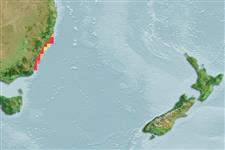Elasmobranchii (sharks and rays) >
Myliobatiformes (Stingrays) >
Urolophidae (Round rays)
Etymology: Urolophus: Greek, oura = tail + Greek, lophos = crest (Ref. 45335).
More on authors: Yearsley & Last.
Environment: milieu / climate zone / depth range / distribution range
Ecology
Marine; benthopelagic; depth range 9 - 79 m (Ref. 75595). Subtropical; 27°S - 37°S, 150°E - 153°E (Ref. 75595)
Southwest Pacific: New South Wales, Australia.
Size / Weight / Age
Maturity: Lm ? range ? - 30.9 cm
Max length : 43.3 cm TL male/unsexed; (Ref. 75595); 52.1 cm TL (female)
Short description
Identification keys | Morphology | Morphometrics
This medium-sized species which lacks broad lobes on posterolateral border of nostrils, has the following set of characters: disc subcircular to weakly rhomboidal, width less than 62% TL; internasal flap bell-shaped; tail with well-developed lateral cutaneous folds; stinging spine long, 12-15% TL; dorsal fin low but prominent, free-rear tip over spine origin; total vertebrae 156-170; pre-spine vertebrae 86-95; dorsal surface of disc greenish, paler laterally; usually with dark suborbital blotch and V-shaped interorbital bar (Ref. 75595).
Life cycle and mating behavior
Maturities | Reproduction | Spawnings | Egg(s) | Fecundities | Larvae
Yearsley, G.K. and P.R. Last, 2006. Urolophus kapalensis sp. nov., a new stingree (Myliobatiformes: Urolophidae) off eastern Australia. Zootaxa 1176:41-52. (Ref. 75595)
IUCN Red List Status (Ref. 130435)
Threat to humans
Harmless
Human uses
Tools
Special reports
Download XML
Internet sources
Estimates based on models
Preferred temperature (Ref.
123201): 19.2 - 22.3, mean 20.5 °C (based on 16 cells).
Phylogenetic diversity index (Ref.
82804): PD
50 = 0.5000 [Uniqueness, from 0.5 = low to 2.0 = high].
Bayesian length-weight: a=0.00813 (0.00366 - 0.01807), b=3.08 (2.88 - 3.28), in cm total length, based on LWR estimates for this (Sub)family-body shape (Ref.
93245).
Trophic level (Ref.
69278): 3.5 ±0.4 se; based on size and trophs of closest relatives
Fishing Vulnerability (Ref.
59153): Moderate vulnerability (41 of 100).
Nutrients (Ref.
124155): Calcium = 12.5 [1.6, 246.7] mg/100g; Iron = 0.585 [0.054, 6.844] mg/100g; Protein = 19.6 [14.3, 24.9] %; Omega3 = 0.211 [0.063, 0.611] g/100g; Selenium = 19.5 [3.4, 100.3] μg/100g; VitaminA = 14.3 [1.0, 168.4] μg/100g; Zinc = 0.715 [0.046, 8.591] mg/100g (wet weight);
